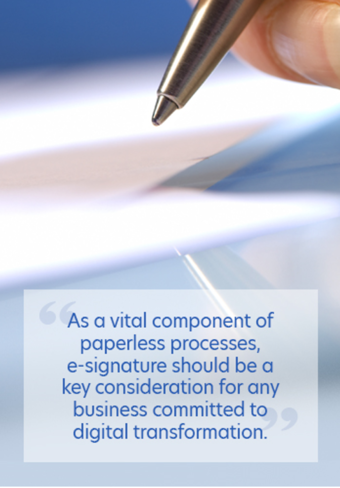E-Signature Need-to-Knows for Global Business
2016-01-13
Paul Giordano, Product Marketing Director KOFAX
SIGNATUS is based on the technologies of Kofax – company number one in field of paperless processing of documents, electronic handwritten signatures and signature verification. This article defines the concept of electronic and digital signature and describes the differences between the two. The article is written for everyone who is interested in the handwritten signature topic.
 Verifying intent and identity electronically
Verifying intent and identity electronically
For hundreds of years, commerce has relied on personal signatures to close deals, onboard customers and verify identity, among other uses. Electronic signatures are becoming increasingly essential for conducting global business and legal transactions in today’s digital world.
Modern e-signatures use secure technology that safeguards against forgery or post-signature alteration. An electronic signature must be as reliable and tamper-proof as a pen-to-paper signature, able to verify the identity of each signor, and validate each signor’s intention to comply with the stipulations of the signed document. When using e-signatures to conduct global business, you need to know the requirements, and the differences between an e-signature and a digital signature.
Electronic signature requirements vary from country to country
Businesses worldwide continue to embrace digital solutions that enhance the customer experience while eliminating cumbersome and costly manual systems. As a vital component of paperless processes, an e-signature solution should be a key consideration for any business that is truly committed to digital transformation. Keep in mind, however, that the requirements in various regions differ. One legally acceptable e-signature in the US may not meet the standards in Europe. For global business, adopting a solution that is accepted worldwide is the beginning of a sound, digital transformation strategy.
What’s in a name? Differences between electronic signatures and digital signatures
When researching a transition to digital business processes, it’s important to use accurate terminology to ensure your e-signature solution is truly complete. The terms “electronic signature” and “digital signature” are not interchangeable, although they are often used this way.
What is an electronic signature (e-signature)?
The U.S. ESIGN Act defines an electronic signature as an “electronic sound, symbol, or process, attached to or logically associated with a contract or other record and executed or adopted by a person with the intent to sign the record.”
E-signatures encompass handwritten signatures, as well as:
- Clicking “I Agree” during an online process
- Capturing a photo at the time of signing and embedding it in a document
- Capturing biometric data, such as signing speed and pressure
Electronic Signature – the EU Definition
Within the EU’s eIDAS-Regulation 2014, e-signatures are just a small part of the new Regulation, but that small part is designed to permit the cross-border recognition as well as European harmonization of e-signatures. The new eIDAS-Regulation has an immediate effect in all 28 EU countries in July 2016 and will cause prior esign acts to become mostly obsolete.
Three types of e-signatures
Neither the 1999 European directive nor eIDAS-Regulation 2014 are restricted by a specific technology. Instead both define three types of e-signatures:
- Electronic signature. Also called a simple e-signature or light e-signature, this is where “data in electronic form which [is] attached to or logically associated with other electronic data, serve as a method of authentication.”
- Advanced e-signature. This category of e-signature meets four standards: 1) it is exclusively connected to the signatory; 2) it can be traced back to the signatory; 3) it is created in a way that only the signatory controls; and 4) later changes are detectable and traceable.
- Advanced e-signature are based on a qualified certificate. This is also called a secure digital signature, strong digital signature, or qualified digital signature. The signature must meet two standards: 1) it is created by a secure-signature-creation device (also called a certification authority [CA]; and 2) it must have the technical support needed to ensure the key can neither be forced nor reproduced in a reasonable time.
What is a digital signature?
Digital signatures are considered a subset of electronic signatures. Whereas an electronic signature is a legally binding record, a digital signature refers to the underlying encryption technology that verifies the authenticity of the transaction.
To learn more about using e-signatures to digitally transforming your business, download your copy of our Digital Transaction Management (DTM) buyers’ guide, “Choose the Right Digital Transaction Management Solution for your Organization.”
Learn more about signatus:
E-signature is no longer only for Big Boys







